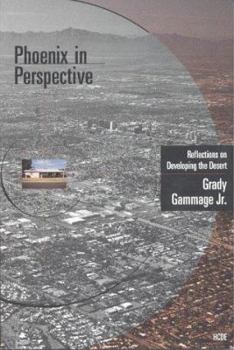Phoenix in Perspective: Reflections on Developing the Desert
Gammage relates Phoenix's development patterns to the historical context. He examines how the region can better manage future growth given the issues of water, transportation, work patterns, and... This description may be from another edition of this product.
Format:Paperback
Language:English
ISBN:1884320171
ISBN13:9781884320170
Release Date:April 1999
Publisher:Herberger Center for Design
Length:192 Pages
Weight:0.95 lbs.
Dimensions:9.0" x 0.8" x 6.3"
Customer Reviews
2 ratings
"We really lay it on thick"
Published by Thriftbooks.com User , 25 years ago
This is truly a disappointing and shocking book; and, for that reason, a must read in any city where residents want to stop or at least curtail the destruction of their community by developers whose only motive is greed. Grady Gammage Jr. is the son of one of Arizona's great families; Gammage auditorium at Arizona State University, designed by Frank Lloyd Wright, honors decades of contributions by his family. Instead of community service, he became a wealthy lawyer for developers and was instrumental in creating the urban blight he so skillfully outlines in this book. A hundred years ago, Phoenix was the smallest of the four major Southwestern cities (the others are Tucson, Albuquerque and El Paso). Now it is the largest, and is growing by an acre of new homes per hour. At that rate, as Gammage notes, growth can continue uninterrupted for another 672 years. What is the new Phoenix? In Gammage's words, "A small narrow lot, a relatively large house, and a two- or three-car garage combine to produce neighborhoods with a different feel than those of even ten years ago. Houses seem squeezed together by non-existent side yards. Garage doors, lined up to a mandatory setback line, become the dominant feature of the streetscape. Front yards are shallower, with less grass . . . the desert is covered by acres of concrete tile." Everything is geared to growth, at the lowest possible cost to developers. When the first Interstate freeway was built through Phoenix in the 1960's, it went below ground in elite neighborhoods and then soared to 25 feet above ground in low income areas. The elevated portion was often called "our Berlin Wall" and it destroyed poorer neighborhoods, providing cheap land for "slum clearance" and industrial space. No interchange was ever built to serve Guadaloupe, a low-income Yaqui village on the freeway; but, when a developer was appointed to the highway commission, bulldozers were at work within six months building an interchange for his speculative subdivision. Obviously, as an attorney for developers, Gammage doesn't highlight problems. Yet, two out of three new residents to Arizona leave the state within five years. The Phoenix downtown crime rate is five times the national average. Arizona has the highest percentage of children without adequate medical care of any state, including Texas. It has the second-highest high school dropout rate. Believe it or not, here in the Sonoran Desert, it's against the law to grow sagebrush in your front yard. It's what makes this book so worth reading. It's a lesson in every sweet-talkin' word that you'll ever hear from developers and their lawyers. Read it in conjunction with `The Death and Life of Great American Cities" by Jane Jacobs, often regarded as one of the great urban thinkers of the past 40 years. This book clearly and proudly offers the opposite of everything Jacobs advocates. For Phoenix residents, it's a chilling account of change from "the city that Los An
America's most thoughtful book on city development
Published by Thriftbooks.com User , 25 years ago
Grady Gammage provides readers with an accurate and insightful account of the development of the Phoenix metropolitan area. More important his book presents a sensible review of the problems of urbanization and suburban growth. Most important it avoids uninformed theories, irrelevant Utopian visions, or public action action that has neither political support nor financial justification.






